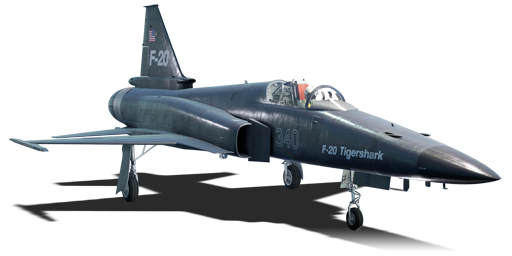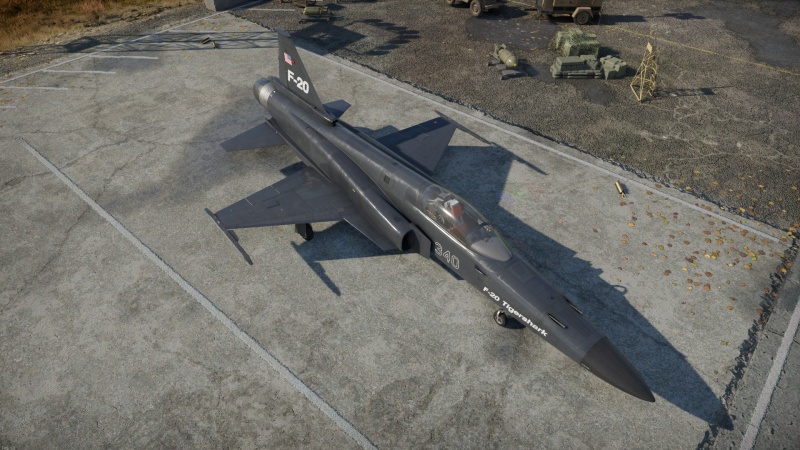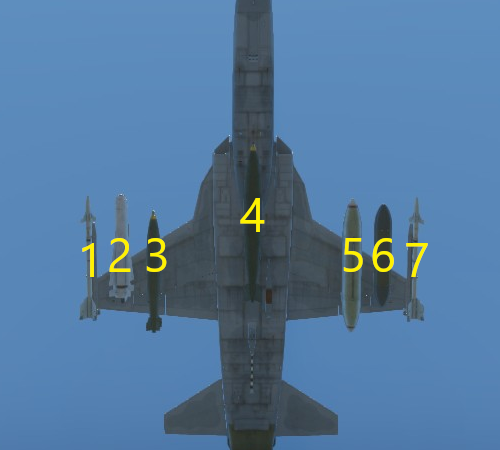Difference between revisions of "F-20A"
(→Flight performance) (Tag: Visual edit) |
m (Reverted edits by U135349539 (talk) to last revision by DnaGonite) |
||
| Line 28: | Line 28: | ||
|- | |- | ||
! Stock | ! Stock | ||
| − | | 2, | + | | 2,149 || 2,121 || rowspan="2" | {{Specs|ceiling}} || 22.5 || 22.7 || 221 || 210 || rowspan="2" | 850 |
|- | |- | ||
! Upgraded | ! Upgraded | ||
Revision as of 17:09, 7 August 2024
Contents
Description
Due to export restrictions by the Department of Defence preventing sales of advanced avionics and aircraft to export customers, many allies who were flying the now out-dated F-5 could not purchase the latest F-16 aircraft to meet the threat of the latest MiG-29s and Su-27s that Soviet allies were receiving. As a result, Northrop Grumman initiated the FX program, to design and build a new 4th light export generation fighter on the basis of the cancelled F-5F Super Tiger. The primary requirements for this new fighter were cheap interoperability with existing F-5 fleets, BVR capability, and modular compatibility with almost every kind of ordnance the US offered for export at the time. The resulting aircraft, the F-20 Tigershark, was essentially an F-5E with a special radar capable of firing the AIM-7 Sparrow missile, and the two small engines of the F-5 family being replaced with a single F-404 engine similar to that of the F/A-18 Hornet. The resulting aircraft was slated to become the export standard for most NATO allies of the time, with Japan, West Germany, Saudi Arabia, Taiwan, and various other close allies eyeing the Tigershark for potential purchase. However, under the Reagan Administration, new export laws were passed which lifted most of the technology export bans, and as a result of further political meddling from the US and General Dynamics, the F-20 saw all its sale chances falter and fall through, with almost every country instead buying F-16s or F-15s (or in the case of Germany, simply upgrading their existing F-4F fleet to carry the new AIM-120 AMRAAM).
The F-20A Tigershark was introduced in Update "Alpha Strike". Being essentially an up-engined F-5E with better avionics, it plays exactly as one would expect it. It is one of the best dogfighters of its battle rating, and is only beaten by the F-16s and in some flight regimes the Mirage 2000. As a result, players looking for buying this aircraft should be expected to know how to properly dogfight, manage their energy, and employ their radar correctly to best the enemy aircraft. The incredible choice of ground ordnance also provides a nice alternative to the F-16A Block 10 in mixed battles. All in all, the F-20 is a great premium for researching the ranks of the US tree, and in terms of gameplay acts as a nice in-between for the two F-16s at the same BR in the American tree, having the AIM-7s and BVR capability of the F-16A ADF, while also having the guided ground ordnance of the F-16A Block 10.
General info
Flight performance
The F-20 is a similar experience in terms of flight performance compared to the F-5C, with great energy retention and turn rate above Mach 0.85. However, due to the F404-100, it has plenty of thrust compared to the lacklustre thrust of the F5C.
| Characteristics | Max speed (km/h at 11,582 m) |
Max altitude (metres) |
Turn time (seconds) |
Rate of climb (metres/second) |
Take-off run (metres) | |||
|---|---|---|---|---|---|---|---|---|
| AB | RB | AB | RB | AB | RB | |||
| Stock | 2,149 | 2,121 | 15240 | 22.5 | 22.7 | 221 | 210 | 850 |
| Upgraded | 2,244 | 2,200 | 21.0 | 22.0 | 288.5 | 255.0 | ||
Details
| Features | |||||
|---|---|---|---|---|---|
| Combat flaps | Take-off flaps | Landing flaps | Air brakes | Arrestor gear | Drogue chute |
| ✓ | ✓ | ✓ | ✓ | X | ✓ |
| Limits | ||||||
|---|---|---|---|---|---|---|
| Wings (km/h) | Gear (km/h) | Flaps (km/h) | Max Static G | |||
| Combat | Take-off | Landing | + | - | ||
| 1,458 | 482 | 1,296 | 473 | 463 | ~12 | ~6 |
| Optimal velocities (km/h) | |||
|---|---|---|---|
| Ailerons | Rudder | Elevators | Radiator |
| < ___ | < ___ | < ___ | N/A |
Engine performance
| Engine | Aircraft mass | |||||
|---|---|---|---|---|---|---|
| Engine name | Number | Basic mass | Wing loading (full fuel) | |||
| General Electric F404-GE-100 | 1 | 6,080 kg | 437 kg/m2 | |||
| Engine characteristics | Mass with fuel (no weapons load) | Max Gross Weight | ||||
| Weight (each) | Type | 8m fuel | 20m fuel | 28m fuel | ||
| 1,015 kg | Afterburning low-bypass turbofan | 6,694 kg | 7,539 kg | 8,127 kg | 10,744 kg | |
| Maximum engine thrust @ 0 m (RB/SB) | Thrust to weight ratio @ 0 m (WEP) | |||||
| Condition | 100% | WEP | 8m fuel | 20m fuel | 28m fuel | MGW |
| Stationary | 5,050 kgf | 7,630 kgf | 1.14 | 1.01 | 0.94 | 0.70 |
| Optimal | 5,050 kgf (0 km/h) |
8,503 kgf (1,000 km/h) |
1.27 | 1.13 | 1.05 | 0.78 |
Survivability and armour
The F-20 is a light fighter. As such it has no armour. If it loses its wing or tail, it becomes incredibly difficult to fly. It isn't that durable against common cannons for its BR, however it's possible to survive smaller IR missiles but the plane would no longer be combat capable and should immediately return to the base.
Modifications and economy
Armaments
| Ballistic Computer | ||||
|---|---|---|---|---|
| CCIP (Guns) | CCIP (Rockets) | CCIP (Bombs) | CCRP (Bombs) | EEGS |
| |
|
|
|
|
Offensive armament
The F-20A is armed with:
- 2 x 20 mm M39A3 cannons, nose-mounted (280 rpg = 560 total)
- 15 x large calibre countermeasures
- 30 x countermeasures
Suspended armament
The F-20A can be outfitted with the following ordnance:
| 1 | 2 | 3 | 4 | 5 | 6 | 7 | ||
|---|---|---|---|---|---|---|---|---|
| 30 mm GAU-13/A cannons (353 rpg) | 1 | |||||||
| 500 lb LDGP Mk 82 bombs | 1 | 1 | 1, 5 | 1 | 1 | |||
| 500 lb Mk 82 Snakeye bombs | 1 | 1 | 1, 5 | 1 | 1 | |||
| 750 lb M117 cone 45 bombs | 1 | 1 | 1 | 1 | 1 | |||
| 1,000 lb LDGP Mk 83 bombs | 1 | 1 | 1 | |||||
| 2,000 lb LDGP Mk 84 Air bombs | 1 | |||||||
| 2,000 lb LDGP Mk 84 bombs | 1 | |||||||
| BLU-1 incendiary bombs | 1 | 1 | 1 | 1 | 1 | |||
| FFAR Mighty Mouse rockets | 19 | 19 | 19 | 19 | ||||
| AGM-65B missiles | 1 | 1 | 1 | 1 | ||||
| AIM-7F Sparrow missiles | 1 | 1 | ||||||
| AIM-9L Sidewinder missiles | 1 | 2* | 2* | 1 | ||||
| 150 gal drop tanks | 1* | 1 | 1* | |||||
| * Wing-mounted drop tanks cannot be equipped with Sidewinder missiles in the adjacent hardpoint | ||||||||
| Default weapon presets | |
|---|---|
| |
Usage in battles
The F-20A can be viewed as both a sidegrade between F-16A and F-16A ADF and a downgrade in US tech tree as it can carry similar armaments to both of them but not to same capacity as either of them. While it can carry almost same payload type as F-16A (excluding GBU-8) it can only carry it in lower numbers which severely limits air-to-ground performance, but unlike F-16A or F-16A ADF it can carry both radar guided missiles and TV-guided AGM to a certain extent.
Best way to take down other planes is to use speed and surprise occupied enemy planes with either the Sparrow (only at altitudes several hundred meters above ground) or Sidewinders but with IR missiles be careful that friendly plane in question isn't the F-14, Su-27 or MiG-29 which have fairly high engine temperature and could result in friendly fire instead.
Dogfighting
While F-20A has amazing flight performance and thrust-to-weight ratio that allows the plane to dogfight inexperienced F-16 and F-14 players, trying to fight more experienced players can end fairly badly for F-20A as the M39A3 is far weaker than 20 mm Vulcan or 30 mm GSh-30-1 cannon and not bleeding enough speed while turning can easily get you ahead of plane you are chasing (and in front of their far powerful guns).
Head-ons are not recommended as the M39A3 is one of the weaker gun in the BR bracket and mounting 30 mm GAU-13/A cannon would only greatly decrease F-20A flight performance to add only 353 30 mm shells.
Air-to-air missile gameplay
F-20A has very limited gameplay in that aspect as it can carry only 6 AIM-9L or exchange 2 Sidewinders for 1 AIM-7F up to combination of 2 Sidewinders and 2 Sparrows. Sadly the F-20A does not have access to AIM-7M unlike F-16A ADF or F-14B which have far lower reaction time after being detached from the plane.
As the plane can gain energy faster than any plane on same BR, it's advised to surprise enemy with AIM-9L or target higher altitude targets with AIM-7F, while keeping safe distance from possible IR threats and staying at low altitude as the enemy planes usually have stronger radar guided missiles.
As the plane has access only to 45 countermeasures, it may not be preferential to split the amount between flares and chaffs as the radars encountered at this BR are usually pulse-doppler, where chaffs have minimal effect and low-alt flights and notching can work instead. Instead, bring flares as the number of tough IR missiles like R-73, AIM-9M, and similar missiles mean the F-20A need all it can bring to ward off these smart IR missiles.
Pros and cons
Pros:
- Incredible overall flight performance with very good thrust-to-weight ratio with great energy retention
- Can stay at supersonic speed without using afterburner
- Combat flaps are capable of withstanding plane top speed
- Very small target compared to all planes it the BR bracket
- Combination of high manoeuvrability and even mediocre missile payload can surprise most enemies resulting in fairly easy shoot-downs.
Cons:
- Loses 2 hardpoints for AIM-9L for every AIM-7F
- M39A3 cannons deal very low damage
- Overall one of the worst air-to-air armaments when compared to planes on same BR
- Can carry only 45 countermeasures
- While it can maintain very low speed and not stalling, it does not have as good low-speed manoeuvrability as other planes
History
In the 1980s, the U.S. State Department sent out a request for an export fighter. In response, Northrop came up with the F-5G, which would be a vastly improved version of the F-5E. After receiving approval from the State Department, Northrop, without financial help from the government, began work on the F-5G. Up to this point, F-5s had twin J85 engines that produced around 3,000 kilograms of force per engine. These engines would end up being replaced by a single F404 engine that produced far more power at the expense of weighing more. Northrop also heavily modified the wings to increase performance and handling. In addition, the avionics were upgraded, and soon the Air Force ordered a few examples of the F-5G. The F-5G would also receive a new designation to separate it from the F-5 series, the F-20.
Although the F-20 had favorable characteristics, it was overshadowed by the F-16. The Fighting Falcon was simply far superior to the F-20, and the Air Force chose the F-16. This essentially killed the F-20, as there wouldn't be enough demand for it to commence production. Northrop also tried selling the entire F-20 program, but that also failed. Only one surviving F-20 exists and is on display in the California Science Center.
Devblog
Engineers from Northrop Corporation developed the F-20A Tigershark as a deep modernization of the F-5G fighter with improved flight and characteristics at a low cost. This new aircraft received a new power plant consisting of a single General Electric F404-100 engine, advanced avionics and radar, plus an expanded range of weapons. It made its first flight in 1982, where a total of 3 were built for testing. At the time of its creation, the F-20A was a direct competitor to the F-16 fighter jet, but was inferior to it and did not go into mass production. The only surviving F-20A was transferred to the California Science Center and is currently on display as an exhibit.
Media
- Skins
See also
- Related development
External links
| Northrop Corporation | |
|---|---|
| Fighters | P-61A-11 · P-61C-1 |
| Jet fighters | F-89B · F-89D |
| F-5A · F-5C · F-5E | |
| F-20A | |
| Export | ␗F-5A · ▄F-5E FCU |
| USA jet aircraft | |
|---|---|
| Fighters | |
| F9F | F9F-2 · F9F-5 · F9F-8 |
| F-80 | F-80A-5 · F-80C-10 |
| F-84 | F-84B-26 · F-84F · F-84G-21-RE |
| F-86 | F-86A-5 · F-86F-25 · F-86F-2 · F-86F-35 |
| F-89 | F-89B · F-89D |
| F-100 | F-100D |
| F-104 | F-104A · F-104C |
| F-4 | F-4C Phantom II · F-4E Phantom II · F-4J Phantom II · F-4S Phantom II |
| F-5 | F-5A · F-5C · F-5E · F-20A |
| F-8 | F8U-2 · F-8E |
| F-14 | F-14A Early · ▄F-14A IRIAF · F-14B |
| F-15 | F-15A · F-15C MSIP II · F-15E |
| F-16 | F-16A · F-16A ADF · F-16C |
| Other | P-59A · F2H-2 · F3D-1 · F3H-2 · F4D-1 · F11F-1 |
| Strike Aircraft | |
| FJ-4 | FJ-4B · FJ-4B VMF-232 |
| A-4 | A-4B · A-4E Early |
| A-7 | A-7D · A-7E · A-7K |
| AV-8 | AV-8A · AV-8C · AV-8B Plus · AV-8B (NA) |
| A-10 | A-10A · A-10A Late · A-10C |
| F-111 | F-111A · F-111F |
| Other | A-6E TRAM · F-105D · F-117 |
| Bombers | |
| B-57 | B-57A · B-57B |
| USA premium aircraft | |
|---|---|
| Fighters | Thach's F2A-1 · Galer's F3F-2 · F2G-1 · F4U-4B VMF-214 · P-26A-34 · Rasmussen's P-36A · P-40C · P-43A-1 |
| P-47M-1-RE · ⋠P-47M-1-RE · P-51A · P-51D-10 · P-51D-20-NA · ␠Kingcobra · XP-55 | |
| ▃A6M2 · ▃Ki-43-II · ▃Ki-61-Ib · ▃Bf 109 F-4 · ▃Fw 190 A-8 · ▃Spitfire LF Mk IXc | |
| Twin-engine fighters | XP-38G · Bong's P-38J-15 · P-38K · YP-38 · P-61A-11 · XF5F · XP-50 · F7F-3 |
| Jet fighters | P-59A · F-86F-35 · F-89B · F-89D · F-4S Phantom II · F-5C · F-20A |
| Strike aircraft | A-1H · A2D-1 · AU-1 · XA-38 · AV-8A · AV-8B (NA) · A-6E TRAM · A-10A |
| Bombers | A-26C-45DT · B-10B · BTD-1 · PBM-3 "Mariner" · PBM-5A "Mariner" · PV-2D |






